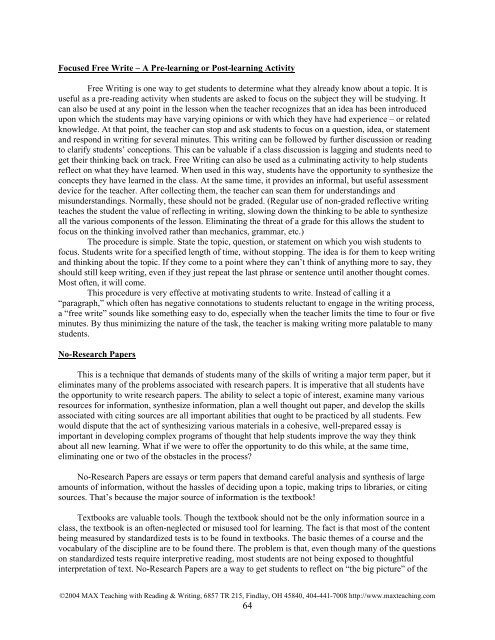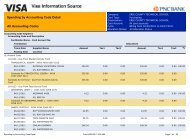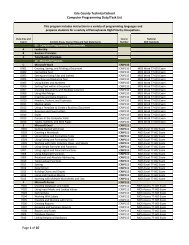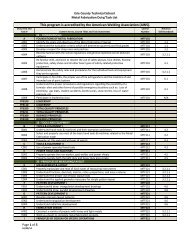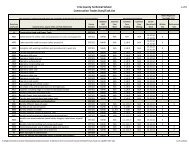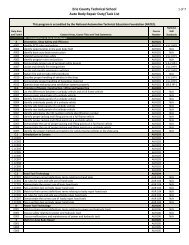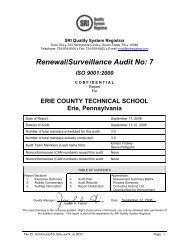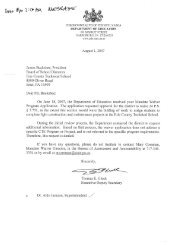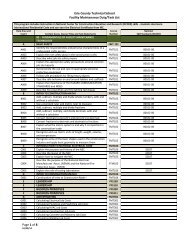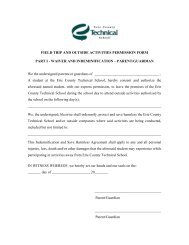MAX Teaching with Reading and Writing - Ects.org
MAX Teaching with Reading and Writing - Ects.org
MAX Teaching with Reading and Writing - Ects.org
Create successful ePaper yourself
Turn your PDF publications into a flip-book with our unique Google optimized e-Paper software.
Focused Free Write – A Pre-learning or Post-learning ActivityFree <strong>Writing</strong> is one way to get students to determine what they already know about a topic. It isuseful as a pre-reading activity when students are asked to focus on the subject they will be studying. Itcan also be used at any point in the lesson when the teacher recognizes that an idea has been introducedupon which the students may have varying opinions or <strong>with</strong> which they have had experience – or relatedknowledge. At that point, the teacher can stop <strong>and</strong> ask students to focus on a question, idea, or statement<strong>and</strong> respond in writing for several minutes. This writing can be followed by further discussion or readingto clarify students’ conceptions. This can be valuable if a class discussion is lagging <strong>and</strong> students need toget their thinking back on track. Free <strong>Writing</strong> can also be used as a culminating activity to help studentsreflect on what they have learned. When used in this way, students have the opportunity to synthesize theconcepts they have learned in the class. At the same time, it provides an informal, but useful assessmentdevice for the teacher. After collecting them, the teacher can scan them for underst<strong>and</strong>ings <strong>and</strong>misunderst<strong>and</strong>ings. Normally, these should not be graded. (Regular use of non-graded reflective writingteaches the student the value of reflecting in writing, slowing down the thinking to be able to synthesizeall the various components of the lesson. Eliminating the threat of a grade for this allows the student tofocus on the thinking involved rather than mechanics, grammar, etc.)The procedure is simple. State the topic, question, or statement on which you wish students tofocus. Students write for a specified length of time, <strong>with</strong>out stopping. The idea is for them to keep writing<strong>and</strong> thinking about the topic. If they come to a point where they can’t think of anything more to say, theyshould still keep writing, even if they just repeat the last phrase or sentence until another thought comes.Most often, it will come.This procedure is very effective at motivating students to write. Instead of calling it a“paragraph,” which often has negative connotations to students reluctant to engage in the writing process,a “free write” sounds like something easy to do, especially when the teacher limits the time to four or fiveminutes. By thus minimizing the nature of the task, the teacher is making writing more palatable to manystudents.No-Research PapersThis is a technique that dem<strong>and</strong>s of students many of the skills of writing a major term paper, but iteliminates many of the problems associated <strong>with</strong> research papers. It is imperative that all students havethe opportunity to write research papers. The ability to select a topic of interest, examine many variousresources for information, synthesize information, plan a well thought out paper, <strong>and</strong> develop the skillsassociated <strong>with</strong> citing sources are all important abilities that ought to be practiced by all students. Fewwould dispute that the act of synthesizing various materials in a cohesive, well-prepared essay isimportant in developing complex programs of thought that help students improve the way they thinkabout all new learning. What if we were to offer the opportunity to do this while, at the same time,eliminating one or two of the obstacles in the process?No-Research Papers are essays or term papers that dem<strong>and</strong> careful analysis <strong>and</strong> synthesis of largeamounts of information, <strong>with</strong>out the hassles of deciding upon a topic, making trips to libraries, or citingsources. That’s because the major source of information is the textbook!Textbooks are valuable tools. Though the textbook should not be the only information source in aclass, the textbook is an often-neglected or misused tool for learning. The fact is that most of the contentbeing measured by st<strong>and</strong>ardized tests is to be found in textbooks. The basic themes of a course <strong>and</strong> thevocabulary of the discipline are to be found there. The problem is that, even though many of the questionson st<strong>and</strong>ardized tests require interpretive reading, most students are not being exposed to thoughtfulinterpretation of text. No-Research Papers are a way to get students to reflect on “the big picture” of the©2004 <strong>MAX</strong> <strong>Teaching</strong> <strong>with</strong> <strong>Reading</strong> & <strong>Writing</strong>, 6857 TR 215, Findlay, OH 45840, 404-441-7008 http://www.maxteaching.com64


